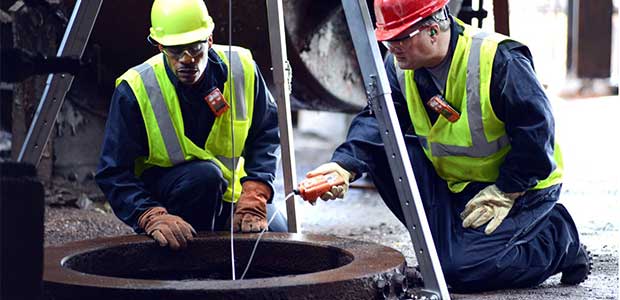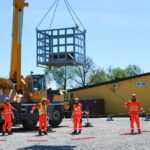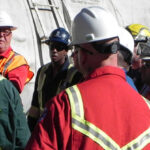
The deadly nature of confined spaces leaves little room for error and even less opportunity to “learn as you go.” Learning about some common mistakes during confined space entry will go a long way toward establishing a confined space air monitoring program based on industry best practices.
Mistake No.1 – Not knowing OSHA confined space standards and recommendations
Understanding what kind of hazards may be present in a confined space entry involves familiarity with OSHA confined space standards.
A confined space as defined in OSHA’s confined space standard, 29 CFR 1910.146, is any space that is large enough and configured so that an employee can bodily enter and perform assigned work, has limited or restricted means for entry or exit and is not designed for continuous employee occupancy.
OSHA confined space standards provide a blueprint for procedures and practices that are at the heart of any confined space safety program. In fact many, if not all, mistakes in confined space monitoring could be decreased or eliminated altogether if safety managers and workers simply followed OSHA’s standards and recommendations.
Mistake No.2 – Using your own senses to detect confined space toxic gases
While it is common knowledge that a number of hazardous gases are both colourless and odourless, many people think they can easily recognize the presence of hydrogen sulphide – one of the more common confined space toxic gases.
The problem with this deadly gas is that its distinctive “rotten egg” odour is only perceptible at very low concentrations. At higher levels, hydrogen sulphide has a paralyzing effect on your sense of smell. Even at low concentrations, prolonged exposure can dull the olfactory nerves and make it impossible to accurately detect, even if concentrations suddenly increase.
The only way to safely detect a hazardous atmosphere is with a calibrated direct reading instrument (gas detectors) as described in OSHA’s confined space standard 29 CFR 1910.146.
Mistake No.3 – Disregarding the importance of confined space entry training
When workers are trained on the operation of the instrument and the procedures for confined space monitoring, the risks involved with this type of work can be greatly diminished. One of the more important benefits of training involves an increased awareness of the potential dangers.
Familiarity, complacency and a false sense of security can all lead to abandoning best practices, especially when the time spent working in the space is expected to be minimal. But trained workers know that accidents can happen to anybody and that no matter how much time is spent working in the space, the potential danger remains the same.
Mistake No.4 – Not implementing a gas monitor maintenance program
A sound maintenance program will ensure that your gas monitors will accurately measure the presence of atmospheric hazards and immediately alert the user to a dangerous condition in the confined space.
One common mistake is zeroing the instrument in an environment that contains any significant concentration of a hazardous substance. Using a less-than ideal atmosphere to establish the monitor’s clean-air reference point can lead to inaccurate or even negative readings and an increased risk of safety.
Many equipment end-users also are confused about how – and how often – to bump-test and calibrate their gas monitors. The confusion typically results in ignoring best practices or avoiding the responsibility altogether.
Mistake No.5 – Not knowing which confined space toxic gases may be present
Understanding the work area is essential not only for the purpose of identifying areas that should be labelled permit required confined spaces, but in choosing the type of gas monitor to use.
The most common configuration for a multiple-sensor gas monitor is one that can read levels of oxygen, combustible gases, hydrogen sulphide and carbon monoxide. While monitoring oxygen and combustible gas levels is required, toxic gas hazards vary with different types of confined spaces.
So, to assume that the toxic gases present in any confined space are limited to only hydrogen sulphide and/or carbon monoxide ignores the possibility that different or additional toxic sensors must be used.
Many multi-gas monitors now are available with several toxic sensor options and the flexibility of measuring up to five and even six gases simultaneously.
Mistake No.6 – Not performing a pre-entry test in confined space
An extremely dangerous mistake regarding confined space atmospheric testing is not performing or incorrectly performing a pre-entry test. Wearing a gas monitor into a confined space is not enough to protect from many hazardous conditions that are immediately harmful to the entrant.
OSHA’s confined space standard 1910.146 states that before an employee enters a permit-required confined space, “the internal atmosphere shall be tested, with a calibrated direct reading instrument, for the following conditions namely oxygen content, flammable gases and vapours and potential toxic air contaminants.”
Mistake No.7 – Considering the confined space safe after pre-entry testing
Air monitoring does not end with the pre-entry test. Atmospheric conditions within a confined space are capable of changing rapidly, which makes it very important to continuously monitor for gas hazards. Improvements in technology have made it possible to manufacture gas monitors small and light enough to be comfortably worn without interfering with your work.
Considering this potential of a confined space atmosphere to change rapidly, OSHA requires conducting a “re-entry” test if the confined space has been temporarily unoccupied (for more than 20 minutes).
For all practical purposes, re-entry testing and pre-entry testing are performed in exactly the same manner and should be considered as equally important.
Mistake No.8 – Not assigning an “attendant” during confined space entry
A large part of safely conducting confined space work is to have a designated “attendant” – someone to maintain contact with the entrant while they are in the confined space. The confined space attendant must not be involved with any tasks or distractions unrelated to the safety of the confined space entrant, and must not, under any circumstances, enter the confined space.
If the work is to be performed over an extended period of time, the attendant may be responsible for recording additional atmospheric readings to monitor the safety of the confined space. The attendant should also know the gas hazards and the physical symptoms of exposure in case of an emergency.
Mistake No.9 – Not having a confined space emergency plan
Not knowing what to do in an emergency puts both the entrant and the attendant at greater risk. OSHA statistics of confined space-related deaths show us what to expect when emergency procedures are improvised.
With would-be rescuers making up 60 percent of confined space fatalities, it’s clear that many emergencies are followed with actions based on impulse rather than a rational and thoughtful plan.
The job of the attendant, in an emergency, is not to personally rescue the victims, but to implement the confined space rescue plan. This may involve calling for assistance, ventilating the confined space and/or operating a non-entry, mechanical retrieval system.
In all cases, the attendant must try to maintain contact with the entrant(s) to assure that help is on the way and to gather information about the incident that may be helpful to the rescue.
Equip yourself with the proper confined space entry training to eliminate these common mistakes and the hard lessons that can come with them.
Interested in learning more? Contact us for our confined space entry and rescue training at www.primeliftsafetyng.com.
Call us on +234 8037957878 or Email us at training@primeliftsafetyng.com.










